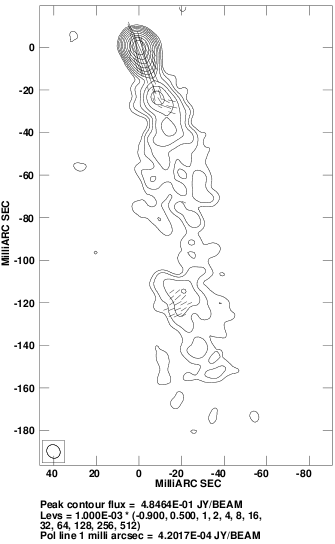MOJAVE Sources
The 18-22cm MOJAVE observations

Fig. 1:Extended intensity and polarization structure in 1823+568; note the detection of strong polarization more than 100 mas from the core.
This large project supplements the available MOJAVE observations with a new set of single-epoch polarization observations of the statistically complete MOJAVE-I sample at 4 wavelengths in the range 18-22 cm. These longer wavelength observations are designed to provide a link between the compact VLBA structures observed at 2cm and the arcsecond-scale structures observed with the VLA, and enable a wide range of total intensity and polarization studies on scales from a few to tens of milliarcseconds (roughly speaking, from parsecs to decaparsecs). The 135 objects in the MOJAVE-I sample have been observed in 9 24-hour sessions at an aggregate bit rate of 256 Mbits/s, which ensured excellent snapshot uv coverage and sufficiently deep observations for all the sources, yielding reliable imaging of the sometimes very rich 18-cm intensity and linear polarization structure, which can extend to 100 mas or more from the VLBA core (e.g. Figs. 1, 2).
The need to derive and correct for Faraday Rotation
Faraday rotation of the plane of linear polarisation occurs when the polarised electromagnetic wave travels through a magnetised plasma. The amount of rotation is proportional to the square of the observing wavelength λ2 and the integral along the line of sight of the electron density nemultiplied by the line of sight B-field component in the plasma; the coefficient of λ2 is called the rotation measure (RM). Because of the λ2 dependence of this effect, even modest RMs can give rise to substantial rotations of the observed polarization position angles at 18 cm. Thus, it is absolutely essential to take the RM distribution into account when deriving the intrinsic B-field structures at such long wavelengths. We do this by observing at four distinct wavelengths in the VLBA 18-22 cm band, similar to the "classic" method that has usually been used for integrated RM measurements using the VLA (e.g., Rudnick & Jones 1983; AJ,88, 518). The availability of 4 wavelengths near 18-22 cm also enables spectral and Faraday-rotation mapping of all objects on the scales probed.
EVPA Calibration Scheme
The absolute calibration of the electric vector position angles (EVPAs) for the VLBI data is done by comparing the VLA and total VLBI polarizations of one or more compact AGN obtained at nearly simultaneous epochs and rotating the EVPAs for the total VLBI polarization to agree with those for the VLA polarization. Up to 8 hours of dynamically scheduled VLA observations in the 18-22cm range were approved for this purpose.
